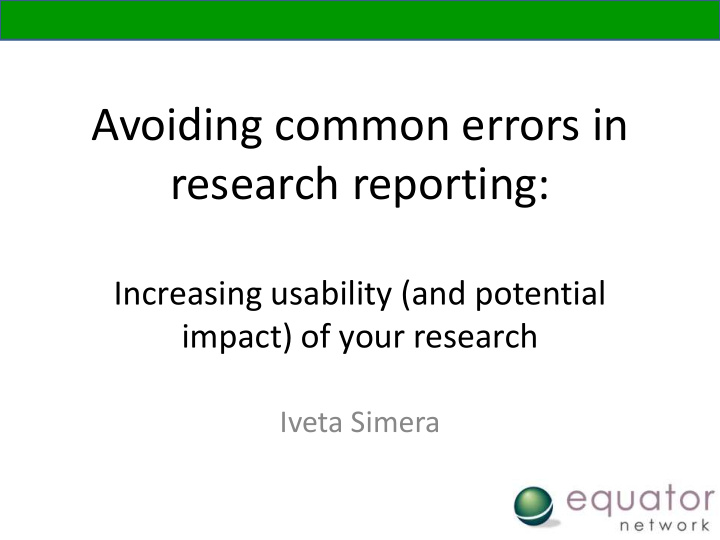



Avoiding common errors in research reporting: Increasing usability (and potential impact) of your research Iveta Simera
Outline • Common reporting deficiencies in published research – Particularly those limiting the usability of articles • Some tips how to avoid these shortcomings
Reporting deficiencies – a big problem for systematic reviews • Key steps: – Formulation of a clear question – Eligibility criteria for studies – Search for potentially relevant studies – Selection of studies into the review – Extraction of data – Assessment of methodological quality of included studies (risk of bias) – Synthesis of findings (possibly using meta-analysis) – Presentation of data and results – Interpretation and drawing conclusions injuries.cochrane.org 3
Looking closely at research • Research on research (meta-research) – Investigating the available research (mostly by looking at research publications, protocols, other information available about research ) • Quite depressing findings
Deficiencies in research literature • Non-reporting (or delayed reporting) of whole studies • Incomplete reporting • Selective reporting • Misleading reporting 7
Non-publication of research • Failure to publish a report of a completed study (even if presented at a conference) • Large number of studies investigating publication bias – 393 RCT presented at Society of Pediatric Research mtgs 1992-1995 – Survey: 166 (45%) response rate • 119 (72%) published as full manuscript • 47 (38%) not published – only 8 submitted • Reasons: not enough time, co-authors problems, journal unlikely to accept, lack of significant findings 8
Consequences of failure to publish • Non-publication of research findings always leads to a reduced evidence-base • Main concern is that inadequate publication distorts the evidence-base – if choices are driven by results Pictures: www.renodis.com; syniadau-- buildinganindependentwales.blogspot.com
Incomplete reporting • Hundreds of published reviews show that key elements of methods and findings are commonly missing from journal reports • We often cannot tell exactly how the research was done • These problems are generic – not specific to randomised trials – not specific to studies of medicines – not specific to research by pharmaceutical companies
RoB assessment by Cochrane authors 11
Poor description of interventions • Hoffmann et al, BMJ 2013;347:f3755 – 133 RCT of NPI published in 2009 in 6 gen med j – Only 53/137 (39%) interventions were adequately described – increased to 81 (59%) by using responses from contacted authors – 46 (34%) had further information / materials available on websites • Not mentioned in the report • Not freely accessible • URL not working
Poor reporting of adverse effects • 78 SR of RCTs of gastroenterology interventions 2008- 2012: – 26 (33%) did not refer to harms of the intervention anywhere in the article – AE data presented in results section frequently misrepresented in the discussion: • Results: “adverse events were not well reported” • Discussion: “adverse events are minimal and the risk benefit ration is good”
Selective reporting Picture: Evaluationtoolkit.org 14
Misleading reporting • “Spin” • “ Specific reporting strategies, whatever their motive, to highlight that the experimental treatment is beneficial, despite a statistically nonsignificant difference for the primary outcome, or to distract the reader from statistically nonsignificant results)”
Boutron et al, JAMA 2010: Evaluation of spin in 72 trials • Title 18 % Title • Abstract 38% Results section of abstract 58% Conclusions section of abstract • Main text 29% Results 41% Discussion 50% Conclusions >40% had spin in 2+ sections of main text
Deficiencies in research literature • Non-reporting (or delayed reporting) of All of these are whole studies very common! • Incomplete reporting • Selective reporting • Misleading reporting 17
Consequences • Low reliability of findings • Impossible to replicate methods • Impossible to reproduce findings • Difficulties in implementing findings in practice (or just understanding the papers!)
Reporting completeness • Reporting guidelines help to improve completeness and transparency of research articles ( www.equator-network.org ) 19
Common errors to avoid • Title – Misrepresents / inadequately describes the article or study design – Includes unclear abbreviation, jargon • Abstract – Information in abstracts does not correspond with the information in the full text (methods, results, conclusions, etc.)
Common errors to avoid (2) • Introduction – Does not describe the purpose and objective of the study – Contains material irrelevant to the study or belonging in other sections of the manuscript
Common errors to avoid (3) • Methods – Reports on methods not used in the study – Described methods do not relate to reported results – Missing or inadequate description (preventing replication of the study): • For example description of study participants, interventions, randomisation in trials, etc. – Poor reporting of statistical methods
Common errors to avoid (4) • Results – Incomplete reporting (data cannot be included in meta-analysis) – Inadequate reporting of harms – Selective reporting of outcomes and / or analyses (e.g. subgroups, alternative analyses) – Presenting results from another study – Text repeats what is show in tables and figures
Common errors to avoid (5) • Discussion – Does not explain key results – Biased, fails to put results in the context of findings from other studies – Does not describe limitations of the study – Overstates conclusions from results (inflates the importance of the study) – Too expansive, lacks logic, includes irrelevant information Common errors adapted from www.sfedit.net
Recommend
More recommend